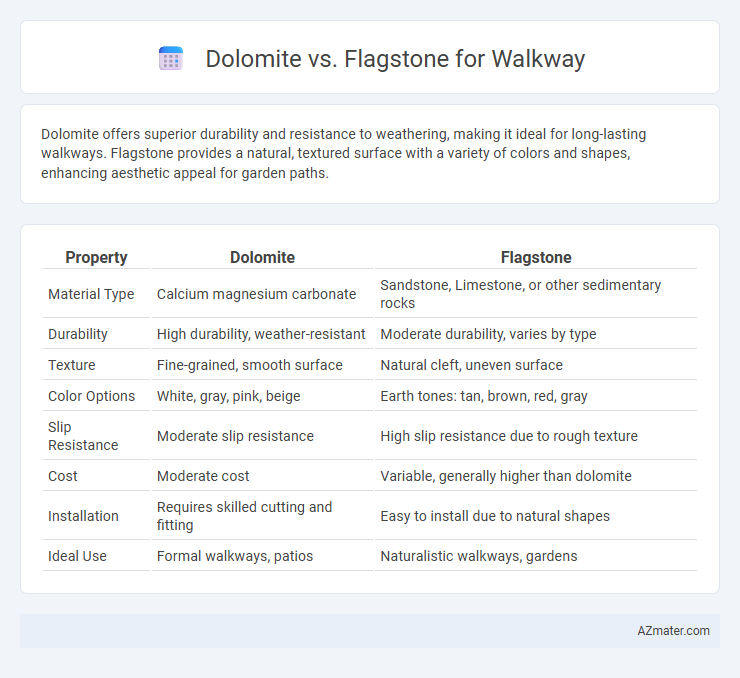Dolomite offers superior durability and resistance to weathering, making it ideal for long-lasting walkways. Flagstone provides a natural, textured surface with a variety of colors and shapes, enhancing aesthetic appeal for garden paths.
Table of Comparison
| Property | Dolomite | Flagstone |
|---|---|---|
| Material Type | Calcium magnesium carbonate | Sandstone, Limestone, or other sedimentary rocks |
| Durability | High durability, weather-resistant | Moderate durability, varies by type |
| Texture | Fine-grained, smooth surface | Natural cleft, uneven surface |
| Color Options | White, gray, pink, beige | Earth tones: tan, brown, red, gray |
| Slip Resistance | Moderate slip resistance | High slip resistance due to rough texture |
| Cost | Moderate cost | Variable, generally higher than dolomite |
| Installation | Requires skilled cutting and fitting | Easy to install due to natural shapes |
| Ideal Use | Formal walkways, patios | Naturalistic walkways, gardens |
Introduction to Dolomite and Flagstone Walkways
Dolomite walkways offer exceptional durability and resistance to weathering, making them ideal for high-traffic outdoor paths. Flagstone walkways are prized for their natural layered appearance and variety of colors, blending seamlessly into garden landscapes. Both materials provide unique textures and aesthetic appeal, enhancing walkway functionality and curb appeal.
Composition and Characteristics of Dolomite
Dolomite is a sedimentary carbonate rock composed primarily of calcium magnesium carbonate (CaMg(CO3)2), giving it a denser and more durable structure compared to flagstone, which is often sandstone or limestone based. Its crystalline texture enhances resistance to weathering and erosion, making dolomite ideal for high-traffic walkways that require longevity and low maintenance. The natural sheen and varying hues of dolomite also provide aesthetic versatility, distinguishing it from the typically flat and matte appearance of flagstone.
Unique Features of Flagstone
Flagstone features a naturally flat surface with varied textures and earthy tones, making it an ideal choice for walkways requiring a rustic, organic appearance. Its layered sedimentary composition allows for easy splitting into irregular shapes, enhancing design versatility and providing excellent traction. Unlike dolomite, flagstone is more porous, promoting water permeability and reducing slip hazards in wet conditions.
Aesthetic Appeal: Dolomite vs Flagstone
Dolomite offers a sleek, uniform appearance with subtle color variations that enhance modern walkway designs, while flagstone presents a more rustic, natural look with diverse shapes and earthy tones. The fine-grained texture of dolomite ensures a polished finish that complements minimalist landscapes, whereas flagstone's irregular surfaces provide a charming, organic aesthetic suited for traditional or cottage-style settings. Choosing between dolomite and flagstone hinges on the desired visual impact, balancing smooth elegance against rugged natural beauty for walkways.
Durability and Long-Term Performance
Dolomite offers exceptional hardness and resistance to wear, making it highly durable for walkway surfaces subjected to heavy foot traffic and harsh weather conditions. Flagstone, while aesthetically versatile with various colors and textures, generally has a softer composition that may be prone to chipping and erosion over time. For long-term performance, dolomite walkways require less maintenance and retain structural integrity better than flagstone, making them a preferred choice in demanding outdoor environments.
Installation Process Comparison
Dolomite walkways require precise cutting and shaping with specialized masonry tools due to the stone's dense, hard texture, ensuring tight and stable fitting. Flagstone, being softer and more irregular, allows easier manual breaking and placement, often resulting in a more natural, rustic look with less labor-intensive installation. Both materials benefit from a well-prepared, level base, but dolomite typically demands more time and expertise to achieve a smooth, uniform surface compared to the flexible layout options of flagstone.
Maintenance Requirements for Each Material
Dolomite walkways require regular sealing and occasional resealing to prevent water absorption and surface staining, while flagstone demands less frequent sealing due to its natural weather resistance. Both materials benefit from routine cleaning with mild soap and water to remove dirt and debris, but flagstone's irregular surface may trap more organic matter, necessitating periodic brushing. Dolomite's smoother texture allows easier maintenance, although it can be more susceptible to chipping and erosion compared to the durable, dense composition of flagstone.
Cost Analysis: Dolomite vs Flagstone Walkways
Dolomite walkways generally offer a more budget-friendly option, with pricing typically ranging from $2 to $7 per square foot, while flagstone costs can be higher, averaging $7 to $15 per square foot due to its natural durability and aesthetic appeal. Installation costs for dolomite are often lower as it is easier to cut and shape, reducing labor expenses compared to flagstone, which requires specialized tools and expertise. Maintenance costs also favor dolomite, as its density provides decent weather resistance without the frequent sealing required for flagstone, making dolomite a cost-effective choice for long-term walkway projects.
Slip Resistance and Safety Factors
Dolomite offers excellent slip resistance due to its naturally rough texture and durable mineral composition, making it a safe choice for walkways in wet or icy conditions. Flagstone, while aesthetically pleasing with its varied colors and patterns, can sometimes be smoother and less slip-resistant unless specifically textured or treated. Selecting Dolomite enhances walkway safety by reducing the risk of slips and falls, especially in high-traffic or moisture-prone areas.
Choosing the Best Stone for Your Walkway
Dolomite offers durability and resistance to weathering, making it ideal for walkways in regions with varying climates, while flagstone provides a natural, textured surface with diverse colors and shapes that enhance aesthetic appeal. Considering factors like slip resistance, maintenance requirements, and overall design harmony helps determine the best stone for your walkway. Opt for dolomite if longevity and low upkeep are priorities, or flagstone for a more rustic, customizable appearance that blends with natural landscapes.

Infographic: Dolomite vs Flagstone for Walkway
 azmater.com
azmater.com